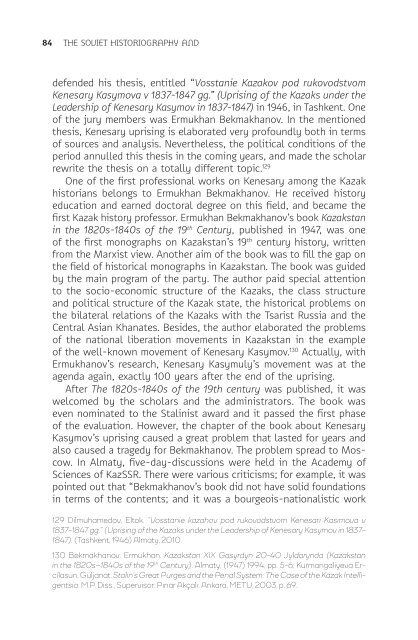THE SOVIET HISTORIOGRAPHY AND THE QUESTION OF KAZAKHSTAN’S HISTORY
SOVYET-TARIH-YAZICILIGI-ENG
SOVYET-TARIH-YAZICILIGI-ENG
You also want an ePaper? Increase the reach of your titles
YUMPU automatically turns print PDFs into web optimized ePapers that Google loves.
84<br />
<strong>THE</strong> <strong>SOVIET</strong> <strong>HISTORIOGRAPHY</strong> <strong>AND</strong><br />
defended his thesis, entitled “Vosstanie Kazakov pod rukovodstvom<br />
Kenesary Kasymova v 1837-1847 gg.” (Uprising of the Kazaks under the<br />
Leadership of Kenesary Kasymov in 1837-1847) in 1946, in Tashkent. One<br />
of the jury members was Ermukhan Bekmakhanov. In the mentioned<br />
thesis, Kenesary uprising is elaborated very profoundly both in terms<br />
of sources and analysis. Nevertheless, the political conditions of the<br />
period annulled this thesis in the coming years, and made the scholar<br />
rewrite the thesis on a totally different topic. 129<br />
One of the first professional works on Kenesary among the Kazak<br />
historians belongs to Ermukhan Bekmakhanov. He received history<br />
education and earned doctoral degree on this field, and became the<br />
first Kazak history professor. Ermukhan Bekmakhanov’s book Kazakstan<br />
in the 1820s-1840s of the 19 th Century, published in 1947, was one<br />
of the first monographs on Kazakstan’s 19 th century history, written<br />
from the Marxist view. Another aim of the book was to fill the gap on<br />
the field of historical monographs in Kazakstan. The book was guided<br />
by the main program of the party. The author paid special attention<br />
to the socio-economic structure of the Kazaks, the class structure<br />
and political structure of the Kazak state, the historical problems on<br />
the bilateral relations of the Kazaks with the Tsarist Russia and the<br />
Central Asian Khanates. Besides, the author elaborated the problems<br />
of the national liberation movements in Kazakstan in the example<br />
of the well-known movement of Kenesary Kasymov. 130 Actually, with<br />
Ermukhanov’s research, Kenesary Kasymuly’s movement was at the<br />
agenda again, exactly 100 years after the end of the uprising.<br />
After The 1820s-1840s of the 19th century was published, it was<br />
welcomed by the scholars and the administrators. The book was<br />
even nominated to the Stalinist award and it passed the first phase<br />
of the evaluation. However, the chapter of the book about Kenesary<br />
Kasymov’s uprising caused a great problem that lasted for years and<br />
also caused a tragedy for Bekmakhanov. The problem spread to Moscow.<br />
In Almaty, five-day-discussions were held in the Academy of<br />
Sciences of KazSSR. There were various criticisms; for example, it was<br />
pointed out that “Bekmakhanov’s book did not have solid foundations<br />
in terms of the contents; and it was a bourgeois-nationalistic work<br />
129 Dilmuhamedov, Eltok. “Vosstanie kazahov pod rukovodstvom Kenesarı Kasımova v<br />
1837-1847 gg.” (Uprising of the Kazaks under the Leadership of Kenesary Kasymov in 1837-<br />
1847). (Tashkent, 1946) Almaty, 2010.<br />
130 Bekmakhanov, Ermukhan. Kazakstan XIX Gasyrdyn 20-40 Jyldarynda (Kazakstan<br />
in the 1820s–1840s of the 19 th Century). Almaty, (1947) 1994, pp. 5-6; Kurmangaliyeva Ercilasun,<br />
Güljanat. Stalin’s Great Purges and the Penal System: The Case of the Kazak Intelligentsia.<br />
M.P. Diss., Supervisor: Pınar Akçalı. Ankara, METU, 2003, p. 69.



